|
"The flex-wing is now frequently
referred to as the 'Rogallo Wing' and the name will probably stick." That quote is from
a 1963 edition of American Modeler - nearly 50 years ago!. Author Scholefield certainly
was correct in predicting that the "Rogallo Wing" moniker will stick. There have been
quite a few articles for such R/C models since then, and I've seen at least one company
advertise a "Rogallo Wing" kit, but if you're interested, the info here should do just
fine.
Flexwings
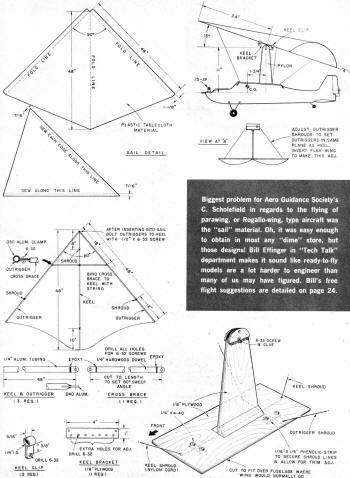
R/C Flexwing by Scholefield
TWO APPROACHES:
1. Simple Radio Control
2. Ready-to-Free-Fly
The construction of the flexwing, as shown in the sketches opposite, requires a minimum
expenditure of time and money while at the same time allows the adventurous modeler to
explore a new realm of flight.
Salient points in construction are the selection of materials. The keel and outriggers
should be as stiff as possible. The first wing used 1/4" dia. hardwood dowels. These
proved fairly successful, but later wings employing aluminum tubing held their shape
better under flight loads.
The
sail material can be purchased at any dime store. I used medium weight sheet plastic
(sold by the yard in 54" widths). The biggest problem here was finding a material with
a pattern other than roses, ivy, or designs for the discriminating housewife. I finally
found a simple blue and white stripe that didn't look too much like a tablecloth.
The shroud line material should be selected for maximum strength. I used nylon lacing
cord. Also all knots should be glued. A broken shroud line will cause a crash that would
do credit to any multi-ship.
The fuselage can be any old rudder - only with .15 to .19 power (Esquire, Charger,
Cub, etc.). I connected all shroud lines directly to the pylon mounting platform so as
to keep the flexwing independent of the fuselage. Strap the pylon to the fuselage with
rubber bands in the conventional manner. Due to the extremely slow flying speed, I would
recommend a generous amount of rudder control. Some flight trim, in addition to shroud
adjustment, may be achieved using elevator shims as required.
Flight characteristics of the present version of the flex wing leave little to be
desired in the area of stability. In fact, this is probably the most "novice proof" ship
ever put into the air.
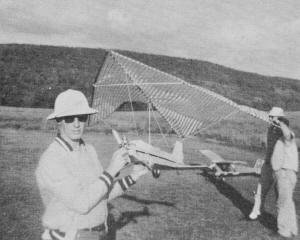 Scholefield's easily-duplicated R/C flexwing.
 The author/designer says any rudder-only
job will do.
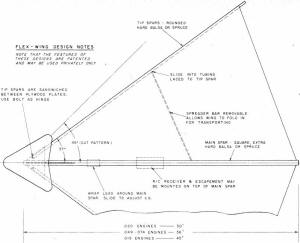 <click
for larger version>
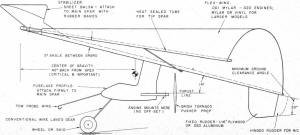 <click
for larger version>
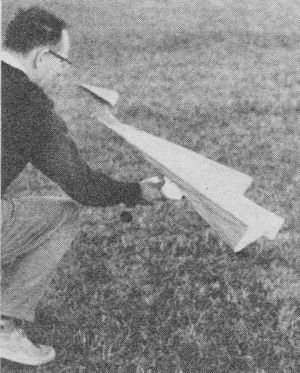 Former National air-model champion Henry Struck
with experimental "Wing Thing."
 John Worth, newly elected president of the Academy
of Model Aeronautics, is seen (left behind simulated rocket section and below starting
R/C plane engine) with NASA flexwing experimental models.

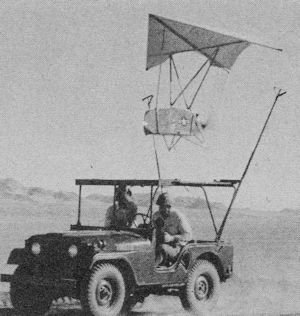
Experimental military drone made by Ryan; took
off and landed from jeep platform under radio control (above).
 Prototype of Gilbert's "Wing Thing" with 36"
main spar; Gilbert·7 engine.
One word of caution, however, in the glide - such as it is - don't expect much control.
At a glide speed of about 5 m.p.h. and a ratio of 1 to 1, full rudder acts about like
a minor trim adjustment. This is not much of a problem if throttle control is employed.
This is a necessity if the full (and only) capabilities of the flexwing are to be realized,
that is touch and go, and spot landings. In all fairness to conventional planes, the
flexwing should be outlawed in any free-for-all spot landing contest.
ROG's are a snap. In fact, the ship has never failed one (in spite of me). Jim Hoover,
a fellow member of the Endicott Aero Guidance Society, ROG'd and flew the same ship at
the October Jersey meet with only 5 minutes of verbal instruction prior to leaving Endicott.
One final virtue of the flexwing is its dual role of sunshade and umbrella! - C. Scholefield,
Binghamton, N. Y.
"Tech Talk" by Bill Effinger
Some may call it "Para-wing," or "Para-glider," but it all adds up to a brand new
type of flying that is the biggest new idea in model aviation since Jim Walker introduced
"U-Control."
For me it started two years ago when A. C. Gilbert's new products planners wanted
a glider kite with some form of power for maneuverability.
Here was a challenge that could not be met with orthodox design. Henry Struck and
I kicked around ideas for several weekends. Being old balsa butchers, we knew that there
were several approaches that offered possibilities, but the weight of ready-to-fly plastic
models was the big drawback.
The NASA flexible wing experiments using a flex-wing in combination with a "Custom
Cavalier" made us consider this possibility. (The original "Cavalier" was designed by
Ben Shereshaw in 1935; I redesigned it as the "Custom Cavalier" in 1941.) NASA Technical
Note D-629 by Rodger Maeseth was the beginning of a long period of "trial and error"
test and research, culminating in Gilbert's new ready-to-fly "Wing Thing" which should
interest everybody as the starting point in flex-wing flying. Model builders will find
new and interesting variations of flex-wing flying, all the way from indoor competition
through radio control.
What have we been able to do with just one airplane? Here is a list of repeatedly
conducted successful flights without structural damage of any kind:
TOWLINE GLIDER: Takes off without assistance. Tows much easier than high aspect ratio
gliders. Sinking speed depends on loading, which can be kept extremely light.
KIT: Has been flown for hours by a 5-year-old. Somebody wisecracked, "The best place
to store Wing Thing is in the air, nobody can step on it then." About 15-mph steady wind
is needed for good kite operations. It is the only kite that glides when the wind dies
down.
FREE FLIGHT: Hand-launched or Rise-Off Ground. Four have been lost to date. Two of
them straight up in thermals.
TETHER: Yes, the fellow who wants to operate on the end of a string in his back yard
can fly Wing Thing on a 15 to 25' tether line.
SLOPE SOARING: If you are lucky enough to live on a hill, you can use it as a hand
launched glider, too!
CAPTIVE FLIGHT: Truly the most sensational new concept in model flying. Catapulted
take-off, towing up to 350 feet on light kite string, steered in flight at the end of
the line, then finally allowed to return to the ground as a guided glider. Not until
you have a line on the model do you realize how high up 350 feet really is.
When the project got under way, NASA Reports were used as design criteria and the
parameters set up proved out in model size. Investigation of past experiments show that
the idea started with the George Wanner Patent No. 2,537,560. Although Mr. Rogallo is
given credit for the flexwing by NASA, the Rogallo Patent No. 2,546,078 differs considerably
from the flexwing that is now being test flown full-scale. I sure would like to see George
Wanner, whose Baby ROG's started so many of us in model building in the late 1920's,
be given some credit for the basic idea. The flex-wing is now frequently referred to
as the "Rogallo Wing" and the name will probably stick. (The basic Wanner patent is now
the property of the A. C. Gilbert Co.)
At the very beginning of the test flying, Struck experienced difficulty with recovery
from stalls. The flexwing as originally designed was intended for use as a kite and had
no means for recovery from a dive once the wings became deflated. In other words, once
zero lift occurred, lift would remain at zero until it made a neat hole in the ground.
The FAA had found out about this and put out warnings as far as full scale planes are
concerned. Experimenters who didn't flight test with models first could learn the hard
way with their lives!
A "bull session" between Hank and myself resulted in the forward stabilizer. This
has solved the stall recovery problem. The stabilizer has sufficient moment to pull the
nose up in any dive. It has the further advantage of holding the airstream over the flexwing
at high angles of attack, similar to a wing slot on a conventional wing.
From this point on, it was a matter of continual flight testing to check the possibilities
of this new type of flying. Our first models were tractors. We used .020 engines for
development work because we could build this size model faster. Tractor engines gave
us trouble in starting because the tow bridle got into the way. The pusher configuration
gave us ease in handling. The rear rudder was added primarily to provide a place to hold
the model when the engine was running. It also gave a good tripod point for R.O.G. flying.
Flex-wings have so light wing loading that very little power is required for flying.
One 8 1/2 ounce version with a Cox .020 had no trouble climbing to the end of a 250-foot
towline on 3/4 of a standard tank of fuel. We found that too much torque and thrust were
a big problem to handle in light tractor models. They would either loop or spin in. Weight
of about 2 to 3 ounces for each .01 cubic inch displacement makes a good sport flying
airplane. No doubt contest flyers will be able to pack in the power and get tight spiral
climbs, but it will take skill and experience.
The flex-wing is quite critical on c.g. location, more so than conventional models.
A movable weight for trimming is incorporated in the ready-to-fly Wing Thing and is recommended
for any home-built designs.
COVER MODEL
A not-so-miniature scale job! Half-size Nieuport 17-C-1 control liner is by Bob Hawk,
21, of 1821 Florida Ave., N.E., Albuquerque, N.M. Bellcrank is 18"; home-made fiberglass
engine cowl; 2 1/2-hp Lawson 4-cycle engine (was auxiliary generator in WW-Two bomber)
swings 3' prop, also home-made. Span 11-ft, length 8 1/2-ft, height 3 1/2 ft, weight
85-lbs. Fuselage of white pine, fir and fir plywood; covering is unbleached muslin. Sliver
aircraft dope finish. Six months to build.
A general layout of the basic design will get you started if you want to build your
own model. Design parameters should be followed fairly closely as they have been determined
after considerable experimentation. Gilbert's Wing Thing should be available at your
local dealer by May 1st. It makes a wonderful model for a son or younger brother to start
free-flight flying. At least, you can use it as an excuse to have a lot of fun yourself
with a ready-to-fly.
Mail Bag. I will be glad to answer any of your letters on anything
that appears in this column. Just write to me, Bill Effinger, c/o American Modeler Magazine,
Conde Nast, 420 Lexington Ave., New York 17, N. Y.
I had a "hot" letter from Bud Tenny, the editor of Indoor News and Views, shouting
that I was against Indoors. Believe me, about the only thing I am against that flies
is the African Tsetse Fly. Unfortunately, I think a lot of the indoor boys have been
bitten by it. I hope they wake up to the fact that we will shortly have enclosed baseball
and football fields in many of the big cities. We will need new events if we want to
get enough people interested to use them for flying.
I had a "nice" letter from George Dabrowsky of Edmonton, Alberta. He likes what I
said about current" contest events and proposed a special "Research and Development"
Event.
Actually, I am hoping we can get model builders throughout the country to form an
organized R & D group willing to take specific test assignments. A future column
will cover some of my experiences with airfoil R & D and how little is really known
about airfoils for models.
Notice:
The AMA Plans Service offers a
full-size version of many of the plans show here at a very reasonable cost. They
will scale the plans any size for you. It is always best to buy printed plans because
my scanner versions often have distortions that can cause parts to fit poorly. Purchasing
plans also help to support the operation of the
Academy of Model Aeronautics - the #1
advocate for model aviation throughout the world. If the AMA no longer has this
plan on file, I will be glad to send you my higher resolution version.
Try my Scale Calculator for
Model Airplane Plans.
Posted November 24, 2012
|



